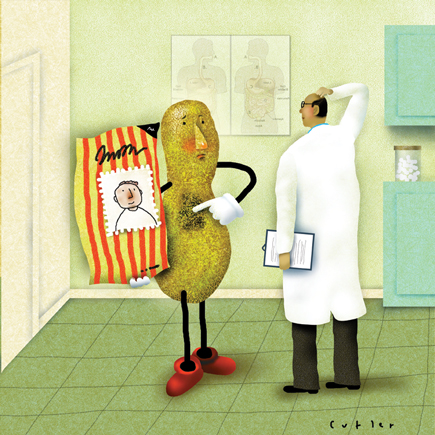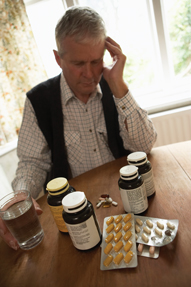Internists don't need to defer treating pain
Pain is one of the most common symptoms seen by primary care physicians, but it can be the most difficult to handle. Chronic pain often requires time-intensive, complex regimens that call for careful management and monitoring, which is not easy to achieve in a busy primary care practice.
Pain is one of the most common symptoms seen by primary care physicians, but it can be the most difficult to handle. Chronic pain often requires time-intensive, complex regimens that call for careful management and monitoring, which is not easy to achieve in a busy primary care practice.
“For internists, if you ask them who their most frustrating patients are, number one is the patient with chronic pain,” said Michael Fingerhood, FACP, a general internist at Johns Hopkins Bayview Medical Center in Baltimore whose five-physician practice treats opioid dependence. “You have to see patients often, there is no perfect answer as to how to take care of them and always in the back of your mind is the potential for abuse.”

Further complicating matters is that most general internists have little training in managing chronic pain.
“The problem goes back to medical school,” said Martin Grabois, MD, professor and chair of the department of physical medicine and rehabilitation at Baylor College of Medicine in Houston. “Medical students aren't being trained [in pain management] and during residencies, internists' pain management experience is very limited compared to other chronic problems, like diabetes.”
But general internists are in the best position to manage the majority of their chronic pain patients because the pain is related to underlying conditions such as osteoarthritis or fibromyalgia, and the primary care physicians may have an ongoing and often longstanding relationship with patients.
And for the most part, such patients are not at high risk for substance abuse, experts said, though precise estimates of risk are not available.
Even if internists would rather refer most patients to pain specialists, that's not always a realistic option considering the high incidence of pain (it affects more Americans than diabetes, heart disease and cancer combined, according to the American Academy of Pain Medicine) and the relative shortage of pain specialists.
Certification is divided among several groups. As of April 2010, about 2,200 physicians had been certified as diplomates by the American Board of Pain Medicine, but that group is not part of the American Board of Medical Specialties, which recognizes 5,166 people through subspecialties such as anesthesiology or physical medicine and rehabilitation.
“The number of people who potentially use opioids require us to have primary care involved,” said Bill H. McCarberg, MD, author of ACP's Expert Guide to Pain Management. “We have to get the message out that primary care has to step up, learn about chronic pain management and learn about the risks.”
Assessing chronic pain
Chronic pain often begins with acute pain triggered by an injury, said Dr. McCarberg. The general internist typically prescribes anti-inflammatories, muscle relaxants or painkillers, orders an X-ray and starts physical therapy. The latter may involve traction, electrical stimulation, posture evaluation and stretching exercises.
“At this point you're six weeks from the initial injury and 90% of the time the pain gets better and the patient goes back to normal function,” said Dr. McCarberg. The other 10% require longer-term treatment and a more complex treatment plan.
Typically, those 10% have already tried NSAIDs and muscle relaxants and are candidates for opioids, he said. The decision to prescribe opioids, which are also used to treat pain arising from underlying diseases or conditions such as arthritis, diabetes, osteoarthritis or migraine headaches, should be guided by a thorough pain assessment, including asking the patient to rate the pain and establishing how it inhibits function, as well as a general medical history and physical exam.
Clinicians should also try to characterize the type of pain, which can help guide treatment decisions. According to “Prescribing Opioids for Chronic Pain: A Resource Manual and Literature Review,” published by the Substance Abuse and Mental Health Services Administration in 2008, terms used by patients such as “aching,” “tight,” “sharp,” “grating,” or “vicelike” suggest nociceptive pain, while “burning,” “electrical,” “shooting,” and “numb” suggest neuropathic pain. However, there is much subjectivity to such descriptions and they are not always diagnostic.
Other suggestions include learning whether the pain radiates and the distribution of pain, the temporal patterns of pain throughout the day, changes in the pain with activity and rest, and its response to treatment. Also important is the evolution of the pain. Was the pain acute or gradual in onset? What events were associated with its development? How has it changed over time? What treatments have been tried, and with what results? What does the patient think is causing the pain?
Responses that might warrant a switch to opioids include when the patient rates his or her pain or function as unsatisfactory or poor (that is, higher than 6 or 7 on a 0-10 scale) despite trying other treatments. But although pain scales are useful, they're also subjective, experts said. More important is establishing a patient's functional limitations and to what extent their pain is limiting basic daily activities such as moving about the home or going to work, said William Becker, MD, a general internist at Yale School of Medicine in New Haven, Conn., who runs a pain consultation practice in the Yale Primary Care Residency Program's faculty and resident clinic.
When interpreting patients' responses to pain scales, Robert L. Barkin, PharmD, MBA, a pain specialist at NorthShore University Health System Pain Centers of Skokie and Evanston Hospitals in Illinois, tells patients that a rating of 10 on a scale of 0-10 is like surgery without anesthesia or childbirth without an epidural.
“The pain scale utilized must be specific to the patient comprehension and their needs,” said Dr. Barkin. He also reassures patients who are already taking opioids that they don't have to keep escalating their pain ratings in order to keep taking their medication.
“Often, the patient will keep the number high to make sure the prescriber maintains their pain medication, but I tell the patient they don't need to do that,” said Dr. Barkin, a professor of anesthesiology, family medicine and pharmacology at Rush University Medical Center in Chicago. “If patient rate their pain as 2-4, I tell them that I won't change anything. Then they are more realistic.”
Creating a treatment plan
Ideally, treatment should be multimodal, combining behavioral and physical therapies with medication, said Dr. Becker. “People struggle with how to use opioids for chronic pain,” he said, “but sometimes focus too much on that instead of the bigger picture, which is doing comprehensive pain management.”
Dr. McCarberg advised starting with a comprehensive approach without opioids, initiating them if the patient still has functional disability and problems performing daily activities after six to eight weeks.
Unfortunately, multidisciplinary pain strategies are difficult to implement because of reimbursement, said Dr. Grabois, who is senior editor of the recently launched journal Pain Management. Pain typically has both physical and psychological components, he said, but insurance coverage for drug therapy tends to be much more generous than for behavioral therapy.
“Forty to 50% of the patients I have on opioids could get off opioids if I had an appropriate program for them to go to,” said Dr. Grabois. “But if you can't get reimbursed for the psychological component, you have to use what's available, such as injection therapy, opioids and physical therapy.”
Before the early 2000s, physicians were taught that opioids were safe, effective and carried a low risk of addiction, said Dr. McCarberg. But as prescriptions for opioids such as Vicodin (acetaminophen and hydrocodone) skyrocketed, it became clear that the drugs are highly addictive for a minority of patients, such as those with a history of abuse or depression.
Clinical guidelines on pain management have added strong language about addiction assessment and now advise physicians to first consider other lines of treatment, said Roger Chou, FACP, a general internist at Oregon Health and Science University in Portland, Ore. He is also the author of several clinical guidelines on pain, including the most recent ACP/American Pain Society Clinical Practice Guideline on evaluation and treatment for acute and chronic low back pain, published in Annals of Internal Medicine in October 2007, as well as the American Pain Society Clinical Practice Guideline on use of opioids for chronic noncancer pain, published in Journal of Pain in February 2009.
“It's not an easy or straightforward decision to go to opioids,” said Dr. Chou. “You have to make an individual decision based on likely benefits and risks.” Patients at risk for abuse include those with a prior personal or family history of substance abuse, underlying depression or other psychological comorbidities, and poorly defined pain that is widespread and cannot be attributed to a specific source after physical examination and diagnostic testing.
Internists must screen carefully before writing a prescription for opioids to identify those at high risk for addiction, said Dr. McCarberg. Internists often neglect to screen because they don't think patients will require long-term treatment, but between 10% and 20% of patients will, he said.
While internists may prefer not to deal with opioids at all because of the potential risks, they should remember that most pain patients do well with opioids and should be managed in the primary care setting, said Dr. Chou. For example, a low dose of hydrocodone and acetaminophen might significantly improve quality of life for a 75-year-old man with hip osteoarthritis who has no history of abuse.
“Pain is extremely common and opioids are a basic part of our armamentarium for treating this condition,” Dr. Chou said. “It is the responsibility of the primary care physician to understand how to assess the benefits and risks and prescribe and monitor these drugs in average-risk patients.”
Monitoring treatment
To clarify expectations for treatment, most pain experts recommend drawing up a treatment agreement, said Dr. Fingerhood. A standard agreement, signed by patient and physician, specifies the details of the medications prescribed and establishes ground rules, such as that the patient cannot get prescriptions in advance of the renewal date and must consent to urine drug screens. (See sidebar for a link to a sample template that applies specifically to opioid treatment.)
“The advantage of using an agreement is that it creates a conversation and shows that you are going to work together with the patient, and emphasizes that there has to be more to treating chronic pain than just taking a pill,” said Dr. Fingerhood. It also provides a basis for discontinuing treatment in the future if the patient violates the terms of the agreement.
Clinical urine drug tests are considered a routine part of monitoring treatment, but there is disagreement about how often they should be performed, how to interpret results and what actions to take, said Dr. Chou.
However, said Dr. Barkin, the tests are the only objective way to measure illicit or non-prescribed drug use. Physicians should review the results of a confirmatory comprehensive clinical urine drug test, which qualifies and quantifies the levels of the medications or substances a patient is taking, before prescribing opioids, he said. (See the story “Opioid abuse potential prompts monitoring role for internists” for more on monitoring opioid treatment and preventing addiction.)
Several other controversies about opioid treatment persist because research has not yet provided consistent answers, said Dr. Chou. Those include the following:
- Increasing dosages. In the past, the consensus held that a ceiling dose for opioids did not exist and clinicians should increase the dose until the pain was under control. However, it has become evident that some patients do not improve with increased dosages and some don't respond to opioids at all. “Trying to understand who would be better off coming down in their dose rather than going up is a big challenge,” Dr. Chou said.
- Clinical outcomes. Some data suggest that early initiation of opioids in patients with low back pain is associated with worse outcomes in terms of work (i.e., function) and risk of overdoses. However, some of those data are based on cohort studies and it is likely that patients getting high doses have other risk factors, besides opioids, for poor outcomes.
- Types of opioids. Long-acting opioids were once considered safer than short-acting opioids, but real-world experiences and researchers have found that substantial abuse and addiction occur with these drugs as well as with short-acting ones, according to Dr. Chou. “The bottom line is that all of these drugs have abuse potential and we need to treat them with the appropriate amount of respect,” he said.
- Methadone. It is often used as a cheaper alternative to other long-acting opioids, but there are concerns about increased accidental overdose potential and cardiac arrhythmias, Dr. Chou said. (See sidebar on the previous page.)
Follow-up and assessment
The ultimate goal of treatment is not to eliminate pain but to increase function and quality of life, experts said. To assess treatment effectiveness, physicians should regularly monitor patients' progress on functional and vocational goals that they set together.
“Most patients will not ever get rid of all their pain,” said Dr. Grabois. “My mantra is managing the pain.”
“Set realistic goals,” advised Dr. Becker. “If they can't get up from their chair at work, how can we control the pain to the point where they can do that? Then use that to benchmark whether the therapy is effective or not.”
Dr. Chou pointed out that cognitive-behavioral principles can be very effective for helping patients cope and function with pain, and that it would be very helpful for general internists to become familiar with basic skills in cognitive-behavioral principles.
Effective bilateral communication is crucial, especially in the early stages of treatment, with patients, family or significant others, said Dr. Barkin, who sees patients on a 30-day cycle for the first three to four months until the pain stabilizes. He gives patients all available information about the drugs they will be taking and discusses the possible side effects and cautions. Patients can call him at any time during the initial phase of treatment if they have questions or problems relating to the pharmacotherapy.
It's important to ensure that patients are clear about the goals of treatment, said Dr. Fingerhood. For example, make sure they know that progress will be measured by increased function as opposed to pain level. If they are taking opioids, they should also be warned about withdrawal symptoms if they stop the drugs abruptly.
“I try to create a snapshot of whatever someone is doing and take that snapshot again after whatever I've done to help them with their pain,” he said. “As a physician, my goal is to get them out walking and doing things, not necessarily to reduce the number on a pain scale.”





